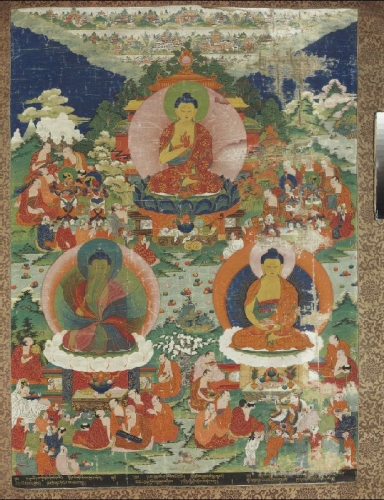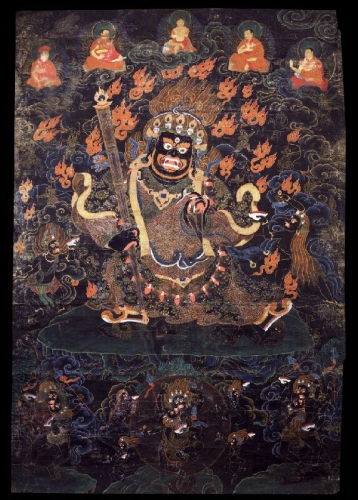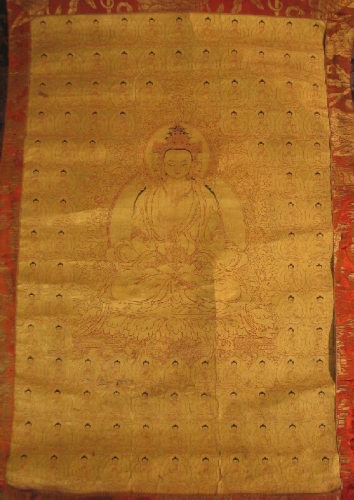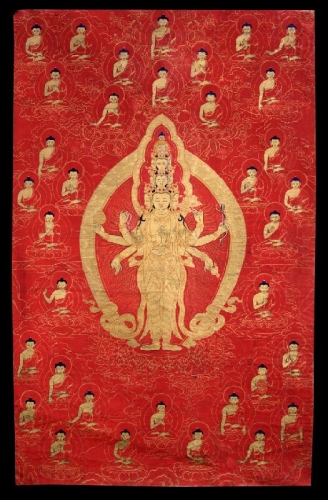Buddhist practice and Buddhist art have been inseparable in the Himalayas ever since Buddhism arrived to the region in the eighth century. But for the casual observer it can be difficult to make sense of the complex iconography. Not to worry—Himalayan art scholar Jeff Watt is here to help. In this “Himalayan Buddhist Art 101” series, Jeff is making sense of this rich artistic tradition by presenting weekly images from the Himalayan Art Resources archives and explaining their roles in the Buddhist tradition.
This week Jeff explores the four ground colors of Himalayan art.
Himalayan Buddhist Art 101: The Four Ground Colors

The “ground color” means the basic foundation or background color of a scroll painting. In Tibetan art there are four ground colors: multi-colored, black, gold, and red. Although the first is not truly a color type, it means that the ground of the painting was created with mixed colors. This type of painting is most common in Tibetan and Himalayan art; their creation is discussed in the early Indian Sanskrit text of the Manjushri Mulakalpa Tantra.
The three remaining colors, black, gold, and red, are according to the chronological order for when each was developed. (The multi-colored paintings were first; red, last.) These three colors are generally used to invoke particular moods, emotions, or perform a specific function. Black is for caution, fear, and protection. Gold is for wealth, wonder, and opulence. Red is for alarm, power, and resolve.

Black ground paintings can be dated to the 14th and 15th centuries following even earlier models where wrathful figures were drawn on a black painted surface created from charnel ground ashes. The textual source for black ground paintings are the Anuttarayoga Tantras of Indian Buddhist literature. Traditionally, black ground is appropriate only for wrathful and fearsome subjects. In the advanced tantric Buddhist system there are four specific activities associated with four colors: peaceful activity with white, increasing activity with yellow, powerful with red, and wrathful with black or dark blue.

Gold ground paintings are believed to follow an early tradition where compositions were applied directly onto Chinese gold silk without any preparation of the surface. Gold ground paintings, made from powdered gold, depict the same subjects as those depicted on the un-grounded silk cloth. Gold ground is commonly used for images of the Buddha, who is said to “shine like a mountain of gold.” Gold silk and painted gold ground developed independently of tantric theory and are the result of what materials are available along with the creativity of the artist and the patronage of wealthy donors.

Red ground, prepared with iron oxide or vermillion, is appropriate for all deities that are classified in Buddhist tantra as power deities [see Jeff Watt’s post on power deities]. It is also used for subjects such as peaceful deities, powerful teachers, and religious leaders. Red ground compositions often include gold outlining or gold fill for the figures. Red ground paintings began to appear as a popular art form in the 17th century, especially in central Tibet, where the art patronage of the Great Fifth Dalai Lama and the 3rd Regeant Desi Sanggye Gyatso flourished.
Red ground and gold ground are often difficult to distinguish as later artists began to combine the two colors in a single composition. The outside ground of one painting might be red while all of the figures in the composition are gold filled. Modern artists tend to follow their own inspiration. Some artists in the late 19th and 20th century worked with silver ground paintings. In these times it is common to find contemporary paintings of a peaceful Tara, Buddha, or any deity depicted on a black, red or gold ground.
Thank you for subscribing to Tricycle! As a nonprofit, we depend on readers like you to keep Buddhist teachings and practices widely available.